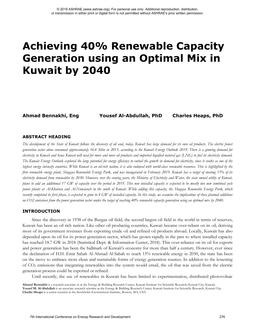Description
The development of the State of Kuwait follows the discovery of oil and, today, Kuwait has large demand for its own oil products. The electric power generation sector alone consumed approximately 16.6 Mtoe in 2015, according to the Kuwait Energy Outlook 2019. There is a growing demand for electricity in Kuwait and hence Kuwait will need for more and more oil products and imported liquified natural gas (LNG) to fuel its electricity demand. The Kuwait Energy Outlook explored the large potential for energy efficiency to curtail the growth in demand for electricity, since it ranks as one of the highest energy intensity countries. While Kuwait is an oil-rich nation, it is also endowed with world-class renewable resources. This is highlighted by the first renewable energy plant, Shagaya Renewable Energy Park, and was inaugurated in February 2019. Kuwait has a target of meeting 15% of its electricity demand from renewables by 2030. However, over the coming years, the Ministry of Electricity and Water, the state owned utility of Kuwait, plans to add an additional 17 GW of capacity over the period to 2035. This new installed capacity is expected to be mostly two new combined cycle power plants at Al-Khairan and Al-Nuwaiseeb in the south of Kuwait. While adding this capacity, the Shagaya Renewable Energy Park, which recently completed its first phase, is expected to grow to 4 GW of installed capacity. In this study, we examine the implications of these planned additions on CO2 emissions from the power generation sector under the target of reaching 40% renewable capacity generation using an optimal mix by 2040.
Citation: 7th International Conference on Energy Research and Development
Product Details
- Published:
- 2019
- Number of Pages:
- 7
- Units of Measure:
- Dual
- File Size:
- 1 file , 1.4 MB
- Product Code(s):
- D-2019ICERD7-034




